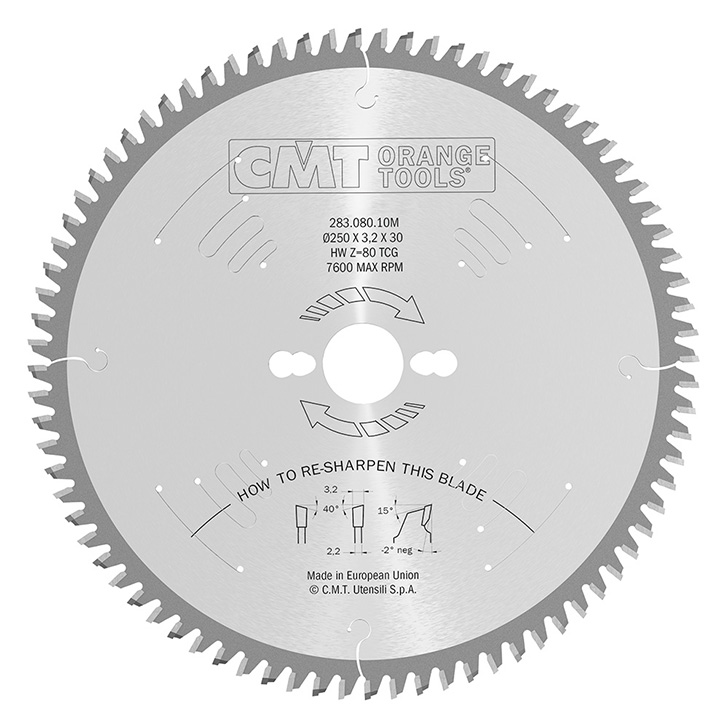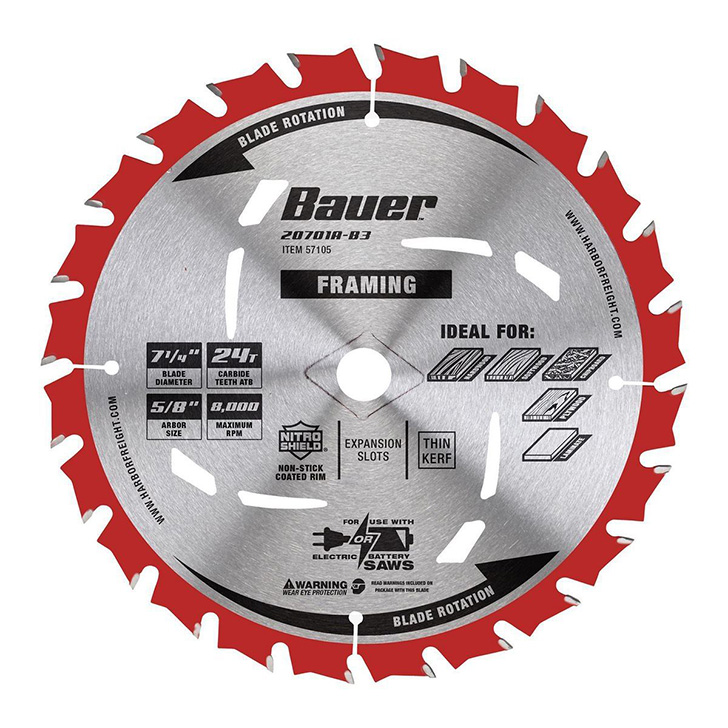When you’re diving into a DIY project or tackling professional woodworking, the right circular saw blade can make all the difference. Choosing the right blade isn’t just about getting the job done; it’s about getting it done efficiently and safely.
You might be wondering which blade suits your specific needs, whether it’s for cutting wood, metal, or other materials. Each type of blade has unique characteristics that could be the key to smoother cuts and less wear on your saw.
Imagine how much easier your projects will become once you understand the differences. By the end of this article, you’ll have the confidence to choose the perfect blade for your next project. So, let’s cut to the chase and explore the various types of circular saw blades that will transform your sawing experience.

Credit: perfect-industry.en.made-in-china.com
Types Of Circular Saw Blades
Circular saws are essential tools for woodworkers and carpenters. Different saw blades cater to specific cutting tasks. Choosing the right blade ensures precision and efficiency. Explore various types to find what fits your needs.
Ripping Blades
Ripping blades cut along the wood grain. They have fewer teeth, typically 10 to 24. This design allows fast cuts. These blades are ideal for thick lumber. They make rough cuts with speed.
Crosscut Blades
Crosscut blades cut across the wood grain. They feature more teeth, often 60 to 80. This provides smooth, clean edges. Ideal for finishing work or detailed projects. They give better control and reduce splintering.
Combination Blades
Combination blades offer versatility. They have 40 to 50 teeth. This allows them to handle both ripping and crosscutting. Perfect for users who need multipurpose tools. They balance speed and smoothness.
Dado Blades
Dado blades are unique. They create grooves or slots in wood. Commonly used for joint work. These blades come in sets for adjustable width. Essential for cabinetry and furniture building.

Credit: m.youtube.com
Material Composition
The material composition of circular saw blades determines their durability and performance. Each type of blade material offers distinct benefits for specific cutting tasks. Understanding these materials helps in choosing the right blade for your needs.
Carbide-tipped Blades
Carbide-tipped blades are known for their long-lasting edge. They feature small carbide pieces attached to the blade’s teeth. This composition makes them ideal for cutting hard materials like wood or metal. The carbide tips resist wear, providing cleaner cuts over time.
High-speed Steel Blades
High-speed steel blades are durable and flexible. They are made entirely from steel, offering resistance to heat and abrasion. These blades are perfect for general-purpose cutting. Their toughness makes them suitable for cutting through wood, plastic, and metal.
Diamond Blades
Diamond blades are designed for cutting hard surfaces. They have diamond particles embedded in the edge. This composition allows them to cut through concrete, tile, and stone. Diamond blades provide precise and smooth cuts, essential for construction projects.
Blade Teeth Design
The design of blade teeth on a circular saw can drastically affect its performance. Different designs suit various materials and cutting needs. Understanding these designs can help choose the right blade for your project.
Flat Top Grind
The Flat Top Grind (FTG) design features teeth with flat tops. This design is ideal for ripping through wood quickly. Its straightforward form allows fast, efficient cuts. Perfect for tasks where speed is essential.
Alternate Top Bevel
Alternate Top Bevel (ATB) teeth have alternating bevels on each side. This design is excellent for cross-cutting wood. It provides cleaner, smoother cuts. Ideal for projects needing precision and finesse.
Triple Chip Grind
Triple Chip Grind (TCG) combines flat and beveled teeth. This design is suitable for cutting hard materials like plastic and metal. It reduces chipping and ensures durability. Great for heavy-duty cutting tasks.

Credit: www.konetool.com
Blade Size And Compatibility
Circular saw blade types vary in size and compatibility, impacting performance and precision. Selecting the right blade ensures smooth cuts and efficient operation. Consider the tool’s specifications and material needs to maximize effectiveness.
When choosing a circular saw blade, the size and compatibility are key factors to consider. A blade that fits perfectly with your saw can make your cutting tasks more efficient and safe. Knowing the right size and type of blade for your specific saw not only optimizes performance but also extends the life of both the blade and the saw.
Standard Blade Sizes
Circular saw blades come in several standard sizes. The most common are 7-1/4 inches, which fits most handheld circular saws. Larger sizes, such as 10 and 12 inches, are typically used for table saws and miter saws. Using a standard size ensures compatibility with many saw models. This makes it easier to find replacements or upgrades. If you’re unsure about your saw’s blade size, check the manufacturer’s specifications.
Specialty Sizes
Some tasks require specialty blade sizes. These may be smaller, like the 4-1/2 inch blades for compact saws, or larger for industrial applications. Specialty sizes often serve niche tasks such as tile cutting or thin-kerf woodworking. Having the right specialty blade can make a big difference. I once struggled with a DIY project until I switched to a thin-kerf blade, which cut smoother and faster. It’s a game-changer for specific jobs.
Matching Blades To Saw Types
Each saw type demands a compatible blade for optimal performance. Miter saws, for example, typically use larger blades for precise angle cuts. A table saw benefits from a sturdy, high-tooth-count blade for rip cuts. Ensure your blade matches your saw’s speed and power capabilities. Using the wrong blade can lead to poor cuts and even damage your equipment. Have you ever had a blade wobble or produce rough cuts? It could be a compatibility issue. Choosing the right blade size and type is crucial. It affects everything from the quality of your cuts to the longevity of your tools. Always check your saw’s manual and choose a blade that fits well with its specifications. You’ll save time, money, and avoid unnecessary frustration.
Choosing The Right Blade
Choosing the right circular saw blade can transform your woodworking projects from mundane to magnificent. Whether you’re a seasoned pro or a DIY enthusiast, understanding blade types is crucial for achieving clean and precise cuts. Imagine working on a project only to realize halfway through that the blade you chose isn’t right for the material. Frustrating, right? Let’s delve into the key factors that should guide your decision.
Wood Type Considerations
The type of wood you’re cutting plays a significant role in blade selection. Softwoods like pine require a blade with fewer teeth for faster cuts, while hardwoods such as oak need more teeth for smoother finishes. Consider the grain; blades with an alternate top bevel (ATB) are excellent for cross-grain cuts. Have you ever tried cutting plywood with a standard blade? It’s not pretty. Use a blade with triple-chip grind (TCG) for composite materials.
Project Requirements
Every project has unique demands. Are you doing rough carpentry or intricate joinery? For rough tasks, prioritize speed over precision with a ripping blade. For precision work, a crosscut or combination blade ensures cleaner edges. Think about the thickness too. Thicker materials require blades with deeper gullets to remove debris efficiently. Are you working on a project that requires curves? Consider a thin kerf blade for smoother maneuverability.
Budget And Quality Balance
Your budget can influence blade choice, but don’t compromise quality for savings. Investing in a high-quality blade can save you money on replacements. Consider carbide-tipped blades for longevity. But if you’re just starting out, economy blades can be a good learning tool. Is it worth spending extra on premium brands? Sometimes yes, especially if durability and precision are non-negotiable for your projects.
Choosing the right blade isn’t just a technical decision; it’s an investment in the outcome of your work. Consider these factors carefully and feel the difference in your projects.
Maintenance And Care
Proper maintenance and care of circular saw blades extend their lifespan. Regular upkeep ensures optimal performance and safety during use. This guide covers essential maintenance practices. Simple steps can keep your blades sharp and ready.
Cleaning And Sharpening
Clean blades after each use to remove debris and pitch. Use a soft brush and mild detergent. Avoid using harsh chemicals or steel wool. For sharpening, use a diamond blade sharpener. Follow the manufacturer’s instructions for best results. Sharp blades cut cleaner and reduce strain on your saw.
Storage Tips
Store blades in a dry, cool place to prevent rust. Use blade cases or hangers for organization. Avoid stacking blades without protection. This prevents dulling and damage. Label storage areas for quick identification. Proper storage extends blade life.
Safety Precautions
Always wear gloves when handling blades. This prevents cuts and injuries. Ensure the saw is unplugged before maintenance. Use protective eyewear when cleaning or sharpening. Follow safety guidelines in the user manual. Safety is paramount during blade care.
Frequently Asked Questions
Which Saw Blades Make The Smoothest Cut?
For the smoothest cuts, use carbide-tipped blades with higher tooth count. Fine-tooth blades reduce splintering and ensure precision. Choose blades designed for your specific material, like wood or metal, for optimal results. Always maintain blades for sharpness to enhance cutting performance and achieve smooth finishes.
What Are The Three Types Of Saw Blades?
The three types of saw blades are rip blades, crosscut blades, and combination blades. Rip blades are for cutting along the grain. Crosscut blades make cuts across the grain. Combination blades handle both rip and crosscut tasks. Each blade type suits specific woodworking needs.
What Is An 80 Tooth Saw Blade Used For?
An 80 tooth saw blade is used for cutting wood, plywood, and laminate smoothly. It provides clean, precise cuts, ideal for finishing work. This high tooth count reduces splintering, making it perfect for fine woodworking projects. Suitable for circular saws and miter saws, it enhances cut quality and efficiency.
What Are The Four Specifications For Circular Blades?
Circular blades have four key specifications: diameter, thickness, tooth count, and material. Diameter determines cutting capacity. Thickness affects durability and cut precision. Tooth count influences cutting speed and finish quality. Material choice ensures compatibility with different materials, enhancing performance.
Conclusion
Choosing the right circular saw blade is crucial. Each type serves a unique purpose. Woodworking, metal cutting, or masonry work all need specific blades. Consider material and project type before deciding. Quality blades ensure clean cuts and longer lifespan. Regular maintenance also enhances performance.
Always prioritize safety while using any tool. Understanding blade types improves efficiency. Make informed choices and benefit from precise results. Happy cutting and crafting!






